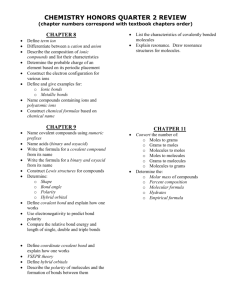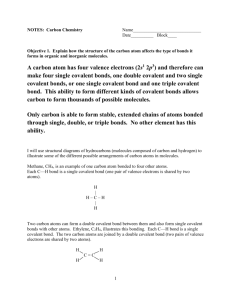polymersANSWERS - chemicalminds
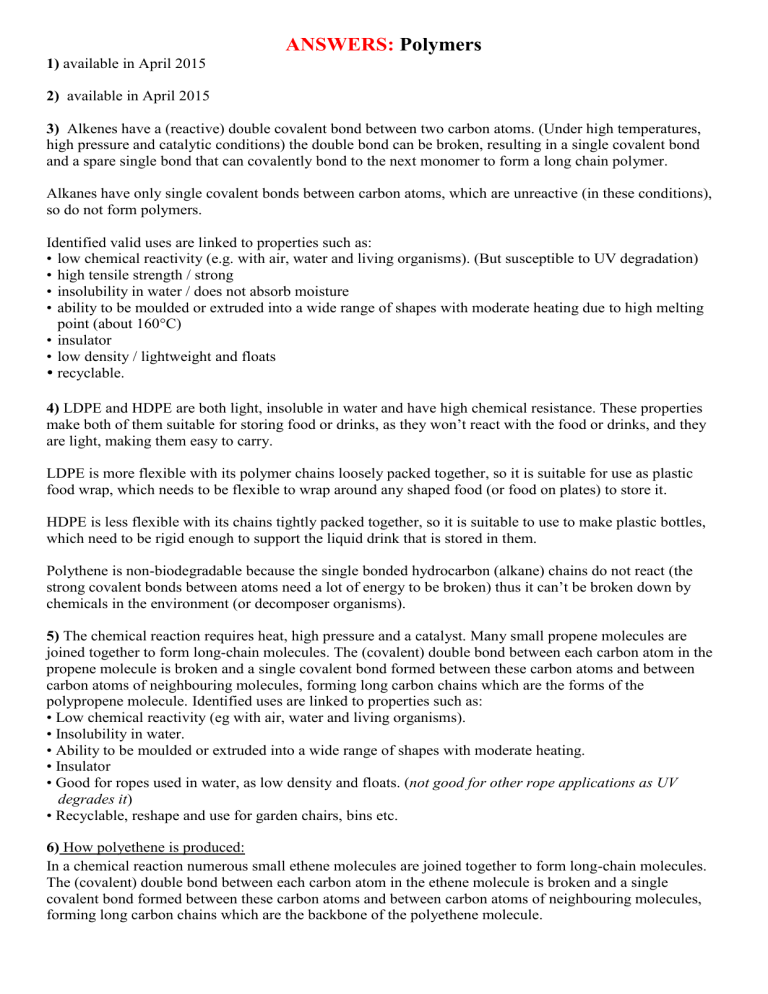
ANSWERS: Polymers
1) available in April 2015
2) available in April 2015
3) Alkenes have a (reactive) double covalent bond between two carbon atoms. (Under high temperatures, high pressure and catalytic conditions) the double bond can be broken, resulting in a single covalent bond and a spare single bond that can covalently bond to the next monomer to form a long chain polymer.
Alkanes have only single covalent bonds between carbon atoms, which are unreactive (in these conditions), so do not form polymers.
Identified valid uses are linked to properties such as:
• low chemical reactivity (e.g. with air, water and living organisms). (But susceptible to UV degradation)
• high tensile strength / strong
• insolubility in water / does not absorb moisture
• ability to be moulded or extruded into a wide range of shapes with moderate heating due to high melting point (about 160°C)
• insulator
• low density / lightweight and floats
recyclable.
4) LDPE and HDPE are both light, insoluble in water and have high chemical resistance. These properties make both of them suitable for storing food or drinks, as they won’t react with the food or drinks, and they are light, making them easy to carry.
LDPE is more flexible with its polymer chains loosely packed together, so it is suitable for use as plastic food wrap, which needs to be flexible to wrap around any shaped food (or food on plates) to store it.
HDPE is less flexible with its chains tightly packed together, so it is suitable to use to make plastic bottles, which need to be rigid enough to support the liquid drink that is stored in them.
Polythene is non-biodegradable because the single bonded hydrocarbon (alkane) chains do not react (the strong covalent bonds between atoms need a lot of energy to be broken) thus it can’t be broken down by chemicals in the environment (or decomposer organisms).
5) The chemical reaction requires heat, high pressure and a catalyst. Many small propene molecules are joined together to form long-chain molecules. The (covalent) double bond between each carbon atom in the propene molecule is broken and a single covalent bond formed between these carbon atoms and between carbon atoms of neighbouring molecules, forming long carbon chains which are the forms of the polypropene molecule. Identified uses are linked to properties such as:
• Low chemical reactivity (eg with air, water and living organisms).
• Insolubility in water.
• Ability to be moulded or extruded into a wide range of shapes with moderate heating.
• Insulator
• Good for ropes used in water, as low density and floats. ( not good for other rope applications as UV
degrades it )
• Recyclable, reshape and use for garden chairs, bins etc.
6) How polyethene is produced:
In a chemical reaction numerous small ethene molecules are joined together to form long-chain molecules.
The (covalent) double bond between each carbon atom in the ethene molecule is broken and a single covalent bond formed between these carbon atoms and between carbon atoms of neighbouring molecules, forming long carbon chains which are the backbone of the polyethene molecule.
7) A polymer is a long molecule made up of many repeating units ( monomers ).
The ethene molecule contains a double bond:
The double bond breaks and single bonds form between the ethene molecules. This is an addition polymerisation reaction. The conditions required include high temperature, pressure and the presence of a catalyst.
© 2015 http://www.chemicalminds.wikispaces.com
NCEA questions and answers reproduced with permission from NZQA


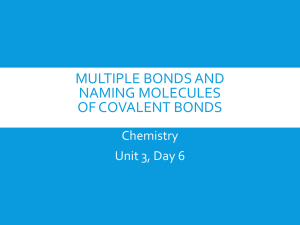


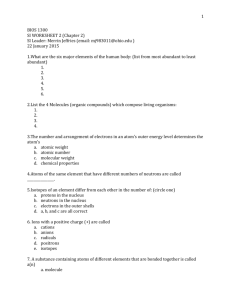


![QUIZ 2: Week of 09.03.12 Name: [7pts] 1.) Thoughtful list of 3](http://s3.studylib.net/store/data/006619037_1-3340fd6e4f1f4575c6d8cf5f79f0ff3e-300x300.png)
